How To Create Blog Content That Builds An eCommerce Store's Brand (and ranks for SEO)


eCommerce has taken the entire world by storm.
Especially since 2020 ...
Remember that little event called Covid19?
All the sudden everyone's holiday savings or government payouts became a surplus of frivolous spending?!?
Local stores profited yes.
But the big cash was made online.
And it hasn't stopped...
Check it out...
- Juniper Research released a study that found the value of eCommerce payment transactions is to exceed $75 Trillion by 2026.
- DigitalCommerce found the coronavirus pandemic added $219 billion to US eCommerce sales in 2020-2021 and still growing.... and Australia followed suit.
- NAB is expecting the online sales boom yet to peak (NAB, 2022)
- Online shopping saw a 60% boost in sales… reaching 55.24 billion in online retail sales in March 2021-22 (Australian Financial Review)
We believe this was always going to happen… but Covid did add a “Hockey Stick” type growth curve to get us there faster.


With all that in mind, many people may think merchandise basically sells itself in the online realm.
Fact is though… that couldn’t be further from the truth.
With consumers’ needs and expectations being so diverse and competition progressively growing, digital marketing strategies… especially SEO is just as crucial for your brand as the products you sell.
And to really turn the heat up in the eCommerce SEO world... having a successful blog makes all the difference.
While your brand’s products and services may take precedence in the eyes of consumers, written content plays a big part if you’re serious about expanding your brand online.
So let’s dive into the "why’s", "how’s" and "what next" to make your eCommerce blog content POP!
Why Do eCommerce Brands Need A Blog?
You may be wondering why eCommerce brands would need a blog.
It’s all about the products, right?
Since they’re what you’re selling, shouldn’t they be the main focus of your website and digital marketing efforts?
While your products should certainly receive their fair share of the spotlight, they won’t necessarily stand on their own.
Your blog can give your brand and products the reinforcement they need to outshine the competition. We include a "content engine" strategy in every SEO campaign we provide as part of our eCommerce SEO services; keep reading to learn how you successfully can do the same.
7 Reasons Informational Content Builds eCommerce Sales
Enhances the customer experience
One of the primary benefits of having a blog is its potential to enhance the customer experience.
No one is arguing that search engine optimisation is king in eCommerce and the online realm as a whole.
Still, the importance of optimising for visitors can’t be ignored.
Makes more memorable initial interactions
Bear in mind, consumers who find your company online will fall into different areas of your conversion funnel.
Some may be ready to make a purchase, but most haven’t quite reached that point when they first discover your brand.
More than 81 percent of shoppers conduct research on brands and products long before making purchasing decisions. (source: CSA The Business Of Retail)
Conscientious consumers want to learn more about your company and what makes it stand out from others in your niche.
They want to find out what sets your products apart from others on the market.
Visitors may even be looking for information about your industry in general.
A blog is a perfect venue to provide that type of information.
Reels in more prospects
On the next level, you’ll have consumers who are ready to dig even deeper.
They want more in-depth information about your products and how to use them.
What features do they have that could benefit them?
How does your brand solve people’s problems or meet their needs?
Again, blog posts give you a way to appeal to those prospects.
You’re bound to have visitors in other stages of the conversion process as well.
From those who aren’t even sure of what they’re looking for to customers who have already bought your products, blog posts can allow you to speak to them all.
Deeper Connections with Consumers
Blogs allow eCommerce stores to make connections with customers and prospects.
People want to be more than credit card numbers these days.
Despite being drawn to online shopping opportunities, they don’t want to be attacked by a slew of barefaced advertising ploys.
They want to see your company’s human side and for you to recognise theirs.
Blog posts are unique in the world of website content because:
- They covertly serve as part of businesses’ marketing and advertising strategies
- They can be used to talk about your products, company, industry, and other relevant aspects without being overly salesy.
- They can be promotional while offering readers far more value than ads.
Additionally, blog posts portray your company and products in a completely different light than other written content.
They could be considered a hybrid between social media posts and the content on your web pages.
They can speak to your company’s social and environmental awareness, its sense of humour, and many other crucial elements you can’t necessarily highlight in other areas of your website.
Boosts Conversion Rates
Since blog posts enhance the viewer experience and builds connections with consumers, they can also boost conversion rates.
Viewers who find the information they’re looking for through your blog posts will be more interested in your brand and products. As such, they’ll be more likely to become paying customers. From there, they could ultimately become repeat customers and immeasurably valuable advocates for your brand.
Don’t overlook the element of trust here, either.
Blog content that’s useful to readers shows them your company cares about more than just making sales.
It’ll help to prove you’re an expert in your field and dedicated to meeting people’s needs.
That’ll prompt consumers to trust your brand, further augmenting conversion rates.
Increases Online Visibility
Blogs can likewise be immensely helpful for increasing businesses’ online visibility.
This is where SEO truly comes into play.
Posts can expand your opportunities for using essential keywords in written and visual content.
That makes your website appear more relevant in the eyes of the search engines.
Blog posts can also give you more ways to incorporate different keywords into written content.
It’s safe to say that hundreds of keywords could be relevant to your industry, niche, brand, and products.
Focusing on all of them in your basic landing pages would be virtually impossible without appearing spammy and raising red flags with search engines.
Blogs can allow you to branch out and cover more topics and for viewers to enjoy based on the keywords they’re searching. They’ll give search engine crawlers more material to take notice of, too.
Furthermore, they can provide more potential for inbound and outbound links. Those can come from your other web pages, your social media content, influencers, authorities in various sectors of your industry, and many other sources. (learn more about eCommerce link building in our eComm Link Building guide)
All those factors can greatly increase your online visibility.
They’ll help to make you appear more relevant where search engines are concerned. They’ll bring about higher engagement rates.
We've developed a whole guide that will help you choose your best keywords, you can learn how to choose the best Keywords for eCommerce SEO here.
A blog sets you apart
All the last 6 points combined make this point pretty obvious.
But the bigger picture is… blogs and posting engaging content for your prospects to consume is one of the most under-utilised SEO strategies in the eCommerce world.
When not many people are doing it… it’s not hard to stand out and set yourself apart.
It’s simply a matter of getting started.
And that’s what the next part of this guide will discuss.
Best content types to use for your business.
What Type of Blog Content Is Effective for eCommerce Sites?
One of the most wonderful attributes of blogs is their versatility.
You can cover virtually any topic you’d like in blog posts.
At the same time, you can incorporate various types of content to better highlight your company and products while making posts more interesting and engaging for readers.
Informational Posts That Help & Sell
Purely informational content is popular among eCommerce sites’ customers and prospects.
This can encompass a long list of subjects.
It can also be as general or as highly focused as you want.
As mentioned earlier, viewers in different areas of your conversion funnel will be reading those posts, so it’s important to cover the full range of consumer interest levels.
For example…
Think about an eCommerce company that sells kitchen gadgets.
Products in that category can pique the interest of professional chefs, experienced home cooks, and kitchen novices alike.
They even appeal to people looking for gifts for the cooking aficionados in their lives.
Quite a few businesses turn to this niche for corporate gifts as well.
House.com.au does a great job at this with blog posts that help people make better buying decisions when it comes to knives.
The company understands that before buying a knife set, people would want to get educated about the type of knife they need.
So they made a blog post about it to get in front of this market, right before the buying decision happens.


More examples of types of informational posts:
- Informational blog posts in this arena could talk about basic relevant matters, like the importance of organisation in the kitchen.
- They could cover ways to keep countertops and cutting boards sanitised.
- Maybe they could go over some of the essential herbs, spices, and other staples people should always have on hand.
- Informational posts can also branch off from those broad topics, becoming progressively more honed along the way.
Posts like these aren’t necessarily designed to sell products.
They’re geared more toward drawing in prospects, making connections, and gaining consumers’ trust.
They can give you endless opportunities for keyword use, incoming and outbound links, and other valuable SEO elements, too.
They’ll likely generate a certain amount of engagement as well.
Those are only a few of the possibilities.
One highly touted example in this category is The Squeeze Magazine, a blog from health food company, PRESS.
Its blog posts cover a vast selection of health-related topics that offer advice and information for readers with diverse needs and interests.


Its blog posts cover a vast selection of health-related topics that offer advice and information for readers with diverse needs and interests.
Tutorials That Build Authority
Tutorials need to be incorporated into your blog content as well.
These can cover ways to use your products.
They may delve into extra features of your products and what makes them different from those competitors have to offer.
Write about ideas to help customers use your products to their fullest benefit and get the most for their money.
Keeping Visitors’ Diverse Needs at the Forefront
These types of posts can speak to prospects who are further along in your sales funnel.
They may not quite be ready to make a purchase just yet, but they’re digging deeper and narrowing down their lists of possibilities.
Tutorials may provide the push it takes to transform qualified leads into paying customers.
On the other hand, tutorials can be written with people who have already purchased your products in mind.
They can even be helpful for people who have purchased competitors’ products.
In that regard, they may sway consumers to switch to your brand.
One of our clients sells outdoor lighting.
While the site ranks for commercial terms that instantly turn into sales, a large amount of the sites traffic comes from tutorials.
Here's an example of a tutorial that helps people set up their garden lights to make their garden more beautiful.
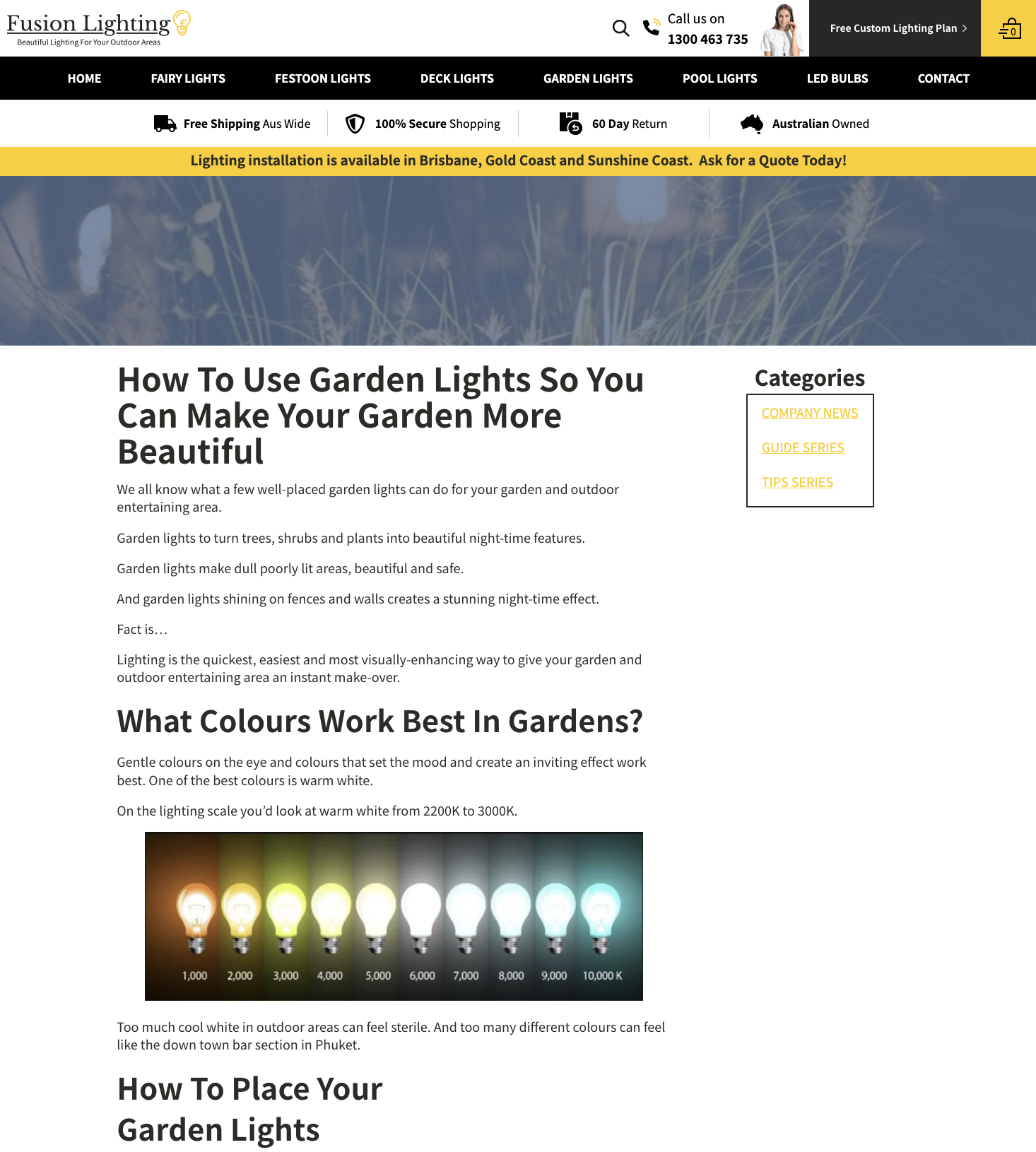

Capitalising on Tutorials
One of the clear frontrunners in the tutorials category is Bunnings.
Their blog provides tutorials that cover a vast range of topics, all of which are relevant to its wheelhouse of products and customers’ interests.
They may mention the brand and its products, but they offer added value for readers.
Bunnings takes it to the next level and also provides demo videos along with their content.
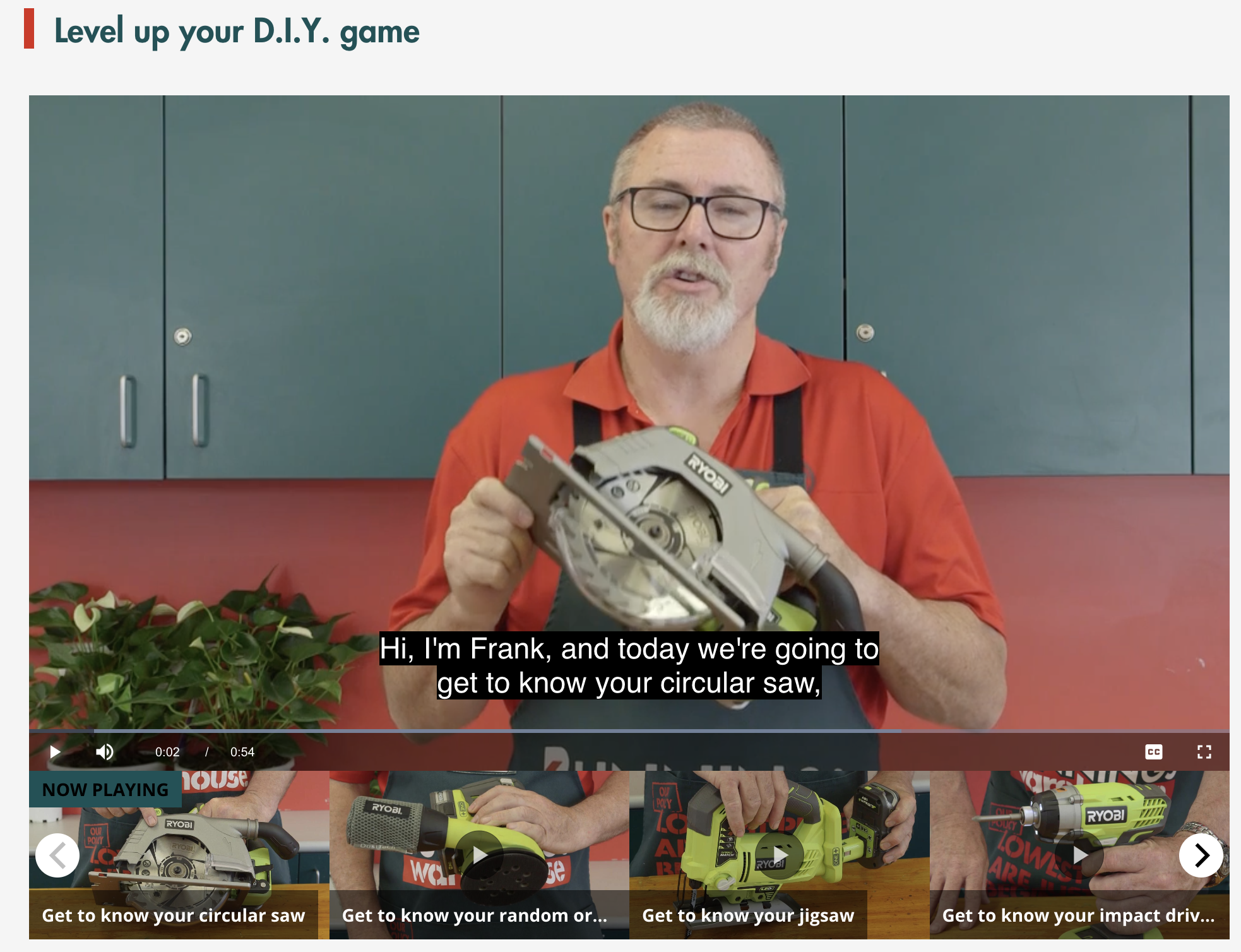

That can certainly be a powerful selling point even if the posts aren’t blatant advertisements.
These types of posts are also sharable, which provides word-of-mouth advertising and added credentials.
Additionally, tutorials can be posted on your social media outlets, YouTube, and other venues for added exposure.
Referring to Bunnings again... YouTube is where they re-purpose their blog content on videos to duplicate their content on multiple online platforms.
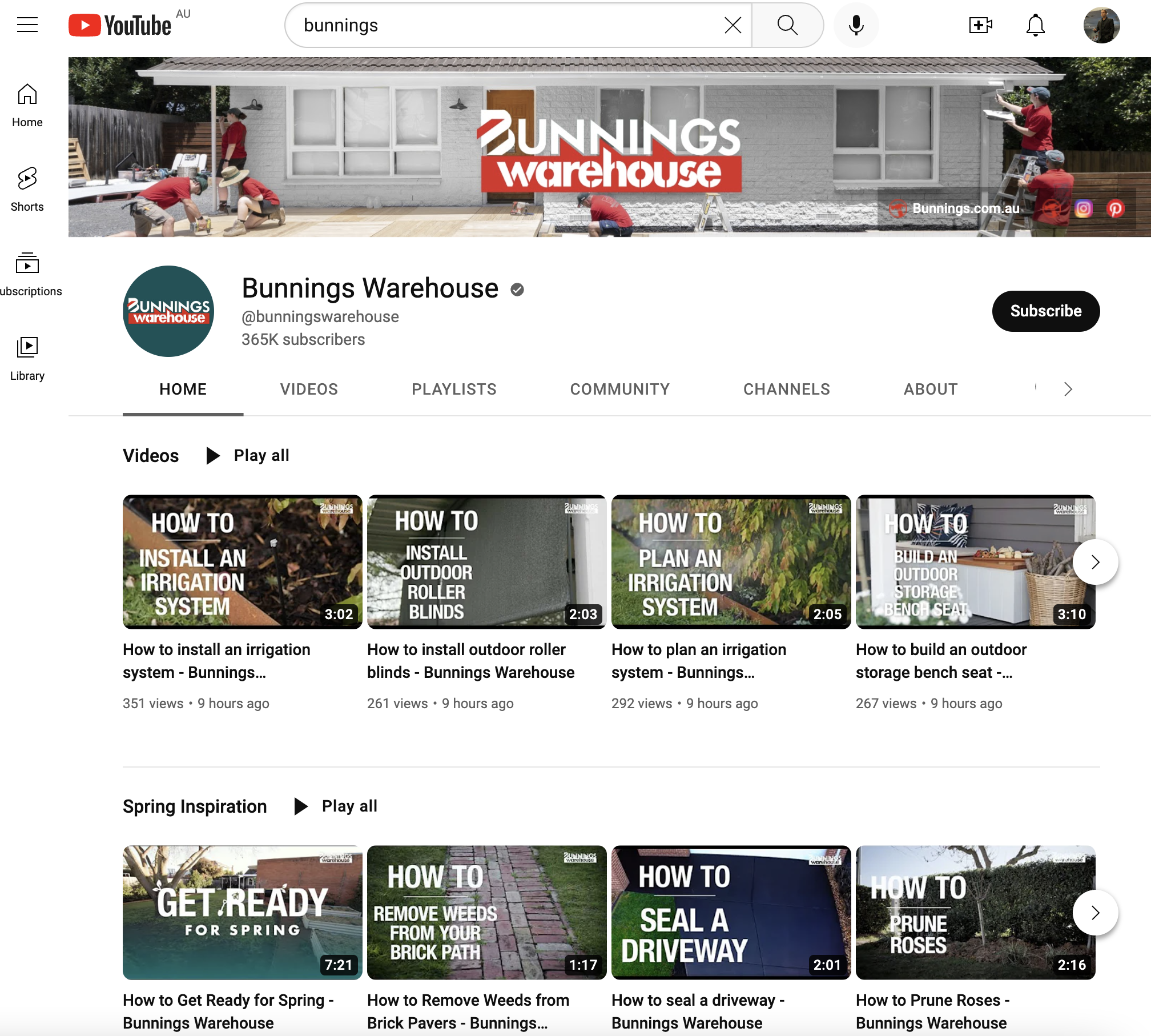

Video tutorial content is exceptionally effective for engagement and conversions.
Posts About Customer Experiences
Incorporating customer experiences into your blog is also an incredibly effective idea.
Invite customers to share their experiences with your brand via reviews, social media, and even private messages.
From there, you could choose some of the most interesting and inspiring ones to elaborate upon in your blog.
We at Websites That Sell utilise this exact strategy with case studies.
Here's what this looks like on our blog.
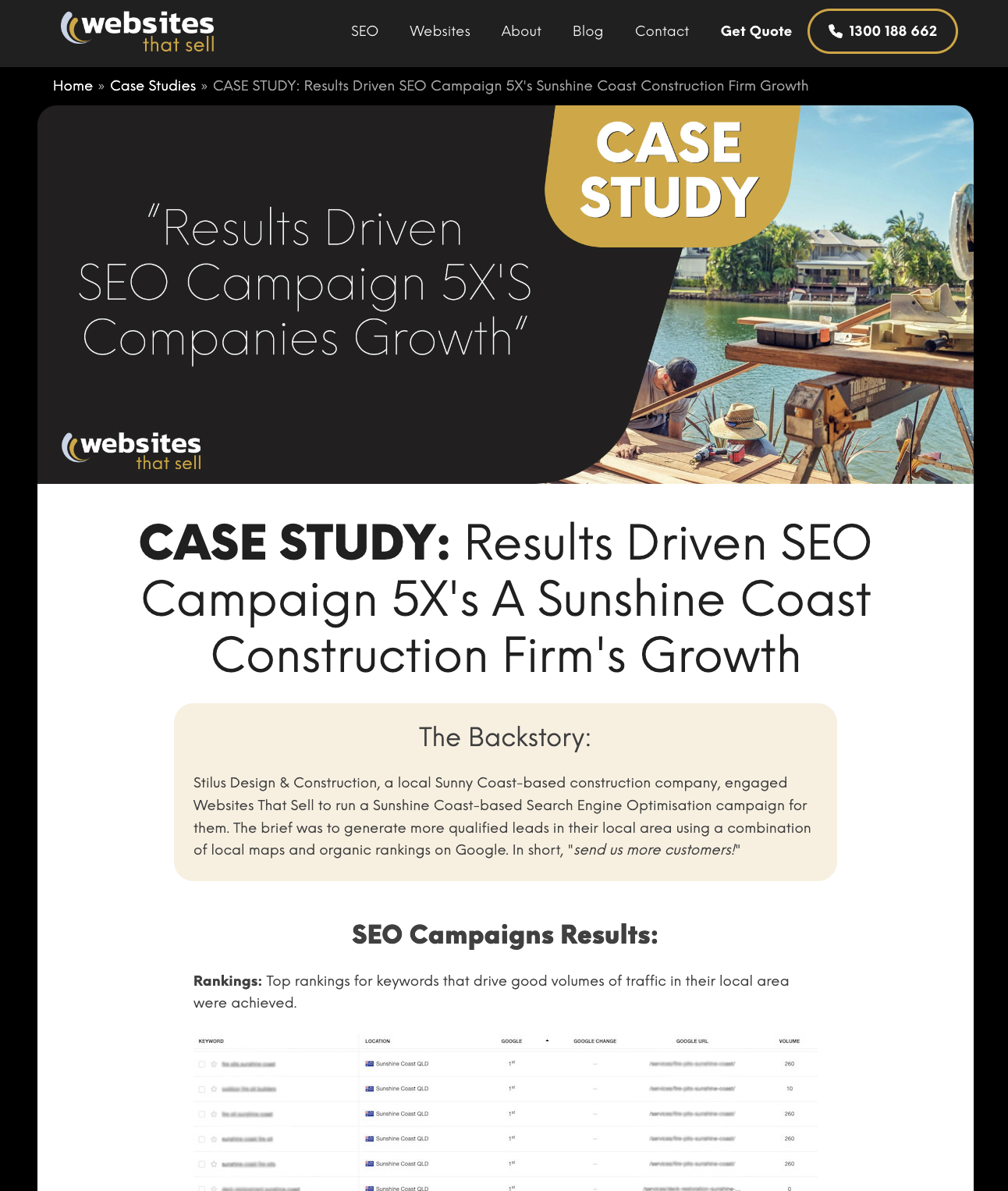

How To Execute This Strategy
- Contact the customers who provided your chosen responses, and ask if they’d be willing to share more in-depth details of their experiences.
- Request interviews with those customers and note down their story (video or notes - Be sure to let them know you’re planning to use their stories in your blog.)
- Write up and illustrate the story they have told you. Add pictures or videos of their interactions with your products to drive home the point.
The Power of Peer Influences
Posts like these go a long way toward making human connections with consumers.
When prospects see actual people enjoying your products in real-world situations, they’re bound to be drawn in.
In truth, sharing customers’ experiences with your brand could also convert those people into loyal customers. After all, you’re giving them recognition and publicity.
Customers you spotlight may tell people in their social circles about the fame they’re gaining on your blog, too.
BOOM by Cindy Josheph, does a great job at this. They call these peers "Ambassadors" and each Ambassador provides valuable information on how they use their skin care products.
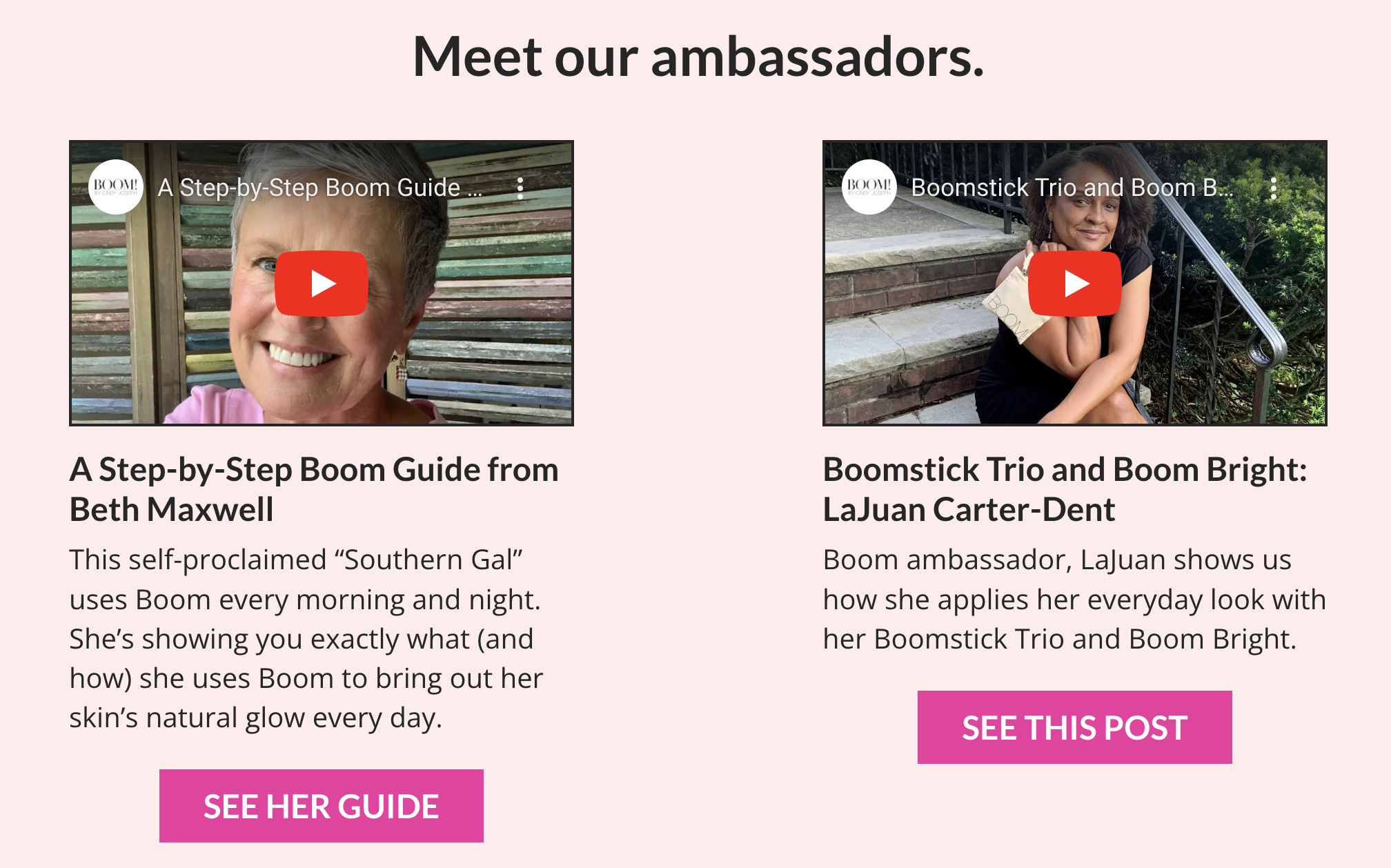

Here's Beth's intro video:
When done correctly this type of content can be responsible for attracting countless new prospects to your brand.
There’s a good chance they’ll proceed to engage with your content and potentially become paying customers, too.
Draw from Consumers’ Questions and Concerns
Another terrific idea for blog content is to address people’s questions and concerns in your posts.
Take a look at some of the questions people ask on social media about your products, company, or subjects relevant to your industry.
Create blog posts that pertain to those matters.
That gives you a great source of topics prospects are interested in reading about.
Chewy a pet food commerce store does a great job at this.
And again it shows... blog posts don't have to be hard. Once you understand what's going on in the mind of your customer and you can answer their questions and concerns better than they can... you become the trusted authority and you get in front of them in Google more and more.
Here's how Chewy did it by answering the age-old question of "Why Do Cats Purr?"


Additional ideas how to execute this strategy:
Honestly, you could use numerous additional resources to find topics to cover.
Check competitors’ websites to see if consumers have asked questions or voiced concerns you could offer insight on. If so, write blog posts on those subjects.
Consider searching Amazon for products similar to the ones you offer.
Browse customers’ questions and remarks on those.
This strategy could provide a wealth of information on consumer interests and blog topics to address them.
Additional Types of Blog Content To Consider
Those are a few of the most popular types of blog posts.
They tend to garner a great deal of reader attention and give companies ways to speak to both prospects and customers.
Here are additional content types that can also be extremely effective:
- Pop Culture that’s Relevant to Your Company or Products
- Current News Stories and Trending Topics
- Behind-the-Scenes of Your Company
- Talk about the Inspirations for Some of Your Products
- Cover Charity Events Your Company Participates in (and Why)
- Tell Readers about Your Eco-Friendly Products or Packaging
- Promote Upcoming Product Launches
You could even help to promote businesses that pertain to your industry in some way as long as you’re not in direct competition with them.
For example, if you sell grills, you could mention a company that sells outdoor cookware and accessories.
Be sure they return the favour, though :-)
Any of these topics could bring in numerous prospects and aid in making conversions.
There’s no real limit to the types of content you could post and the subjects you’re allowed to cover therein.
Don’t hesitate to conduct keyword research to help you find ideas that appeal to consumers while fostering your SEO efforts.
How To Successfully Launch & Manage Your eCommerce Blog
Content is the driving component of any blog.
Still, the types of blog content eCommerce companies post and where they glean their inspirations is only the beginning.
Properly managing your blog along the way can mean the difference between success and failure.
Plan Your Posts
Organisation is essential in all aspects of business, and that applies to blog posts as well.
Take time to create a schedule for posting new blog content.
SEO and digital marketing experts generally recommend posting new content two to four times per week.
That’ll help keep your blog fresh and relevant in the eyes of the search engines, and it’ll give regular followers plenty of material to enjoy.
Keep in mind, setting specific dates and times for new content to be posted is the simplest portion of the process.
You may need to research topics.
You’ll need to allow time for content creation, curation, and refinement so it’ll be ready to post according to schedule.
Developing a timeline for all those facets and sticking to it will be helpful.
Keeping up the process is essential, too.
This isn’t a one-time event; it’s an ongoing project.
Take the time to determine who’s responsible for blog content, posting, and other factors, and make sure everyone involved fully understands his or her role in the process as well.
SEO Is Critical
Also remember that SEO is a critical component of your blog.
Without the right keywords and other measures in place to make posts more visible online, all your blogging efforts will be in vain.
If the search engines don’t notice your posts, index them, and deem them relevant to users’ searches, they’ll never be seen.
If readers don’t find them helpful or interesting once they find them, they’ll be equally ineffective.
Conducting keyword research will be immensely helpful in this regard.
It’ll give you an idea of which phrases customers and prospects are searching for online.
In turn, it’ll give you insight into which topics might draw their interest.
That’s only one metric to factor into the equation, though.
Dozens of SEO elements enter the mix to help make your blog successful.
A great place to start is to use our eCommerce on-page SEO guide to help you optimise your posts properly.
Use Variety And Balance
It’s also best to present a variety of content types to viewers.
Don’t focus on only one or two of the options mentioned above. Instead, incorporate several of them into your blogging repertoire.
You’ll need to add photos, video, and other visual elements to the mix as well.
On top of all that, it’s best to post content of varying lengths.
Longer posts, like those in the neighbourhood of 1,500 words or so, tend to work better from an SEO perspective.
Many readers look for the more in-depth information contained in longer pieces, too.
Conversely, some are looking for more condensed posts, like those in the 500-word range. It all depends on user intent and how long it takes to provide the right level of information to end the specific search.
Be sure to account for this aspect when creating your blogging schedule.
Reach Out For Help
It’s also best to present a variety of content types to viewers.
Don’t focus on only one or two of the options mentioned above. Instead, incorporate several of them into your blogging repertoire.
You’ll need to add photos, video, and other visual elements to the mix as well.
On top of all that, it’s best to post content of varying lengths.
Longer posts, like those in the neighbourhood of 1,500 words or so, tend to work better from an SEO perspective.
Many readers look for the more in-depth information contained in longer pieces, too.
Conversely, some are looking for more condensed posts, like those in the 500-word range. It all depends on user intent and how long it takes to provide the right level of information to end the specific search.
Be sure to account for this aspect when creating your blogging schedule.
How To Effectively Promote Your Blog
Creating the right content and using SEO to your advantage will help to get your blog noticed.
Additional marketing measures will be required to ensure it reaches its full potential, though.
Don’t forget to promote your blog in various ways.
- Create Links from Product Pages (and to your products from blog posts, learn more about this strategy in our Product Page SEO guide)
- Link Blog Posts to Your Social Media Posts
- Send out Newsletters about Your Blog Posts
- Work with Others in Your Industry (have relevant companies promote your blog and promote theirs in return)
- Reach out to Industry Authorities and Ask Them to Provide Guest Posts (ask if they’ll allow you to do the same for them)
Cross-Post Blog Content on Social Media and Other Channels
All these measures will raise awareness of your blog.
They can help make your posts more visible in consumers’ online searches and give prospects greater access to your material as well.
This creates a positive cycle that propels your blog, and your brand, to the top.
How To Maximise The Value Of Your eCommerce Blog
For eCommerce brands like yours, products generally take the spotlight.
Because of that, written content often becomes secondary.
Sometimes, it’s altogether overlooked.
Ignoring the power of written content is a mistake that ultimately causes many eCommerce websites stop growing long term.
Though written content comes in multiple forms, a blog can be your brand’s ticket to stardom.
It’ll help you build trust and forge relationships with consumers.
Blogging is a versatile way to boost your online visibility and drive more traffic to your store.
Blogs provide endless opportunities for eCommerce companies to highlight their brands, products, and what makes them special.
For blogging to be truly effective, though, you’ll need to approach the matter in just the right way.
Keep in mind all the points mentioned here, and don’t hesitate to reach out for help if needed.
ADDITIONAL & RELATED TRAINING RESOURCES:
How To Use eCommerce Category Pages For SEO
